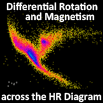Speaker
Julien Morin
(Institut für Astrophysik, Georg-August-Universität Göttingen)
Description
M dwarfs are of prime interest for stellar dynamo theories. They indeed span a wide
range of parameters, in terms of relative depth of the convection zone (the
lowest-mass M dwarfs being fully convective) and rotation. The number of magnetic
field measurements on M dwarfs has been rapidly growing in the past few years, trends
are emerging and now need to be understood in the framework of dynamo theory. In this
talk I will detail the analogy anelastic dynamo simulations by Gastine, Duarte &
Wicht (2012) and observations of M-dwarf magnetism, focusing on field geometries
derived from spectropolarimetric observations carried out with the instruments
CFHT/ESPaDOnS and TBL/NARVAL (Morin et al. 2010 and references therein).
In geodynamo models, the relative importance of inertia in the force balance is known
to have a strong impact on the magnetic field geometry. This can be quantified by
the so-called "local Rossby number", which has been found to be a rather universal
quantity that allows to separate dipolar and multipolar dynamo models. I will discuss
its relevance in setting the field geometry of M dwarfs and the transition towards a
bistable regime (Gastine et al. 2013). In the dynamo models of Gastine, Duarte &
Wicht (2012) a strong correlation exists between the type of magnetic field generated
and differential rotation, I will detail an ongoing observing campaign aimed at
finding evidence of this behavior among very-low-mass stars.
Authors
Ansgar Reiners
(Universitaet Goettingen)
Johannes Wicht
(Max-Planck-Institut für Sonnensystemforschung, Lindau)
Julien Morin
(Institut für Astrophysik, Georg-August-Universität Göttingen)
Lúcia D. V. Duarte
(Max-Planck-Institut für Sonnensystemforschung, Lindau)
Thomas Gastine
(Max-Planck-Institut für Sonnensystemforschung, Lindau)
Ulrich R. Christensen
(Max-Planck-Institut für Sonnensystemforschung, Lindau)

